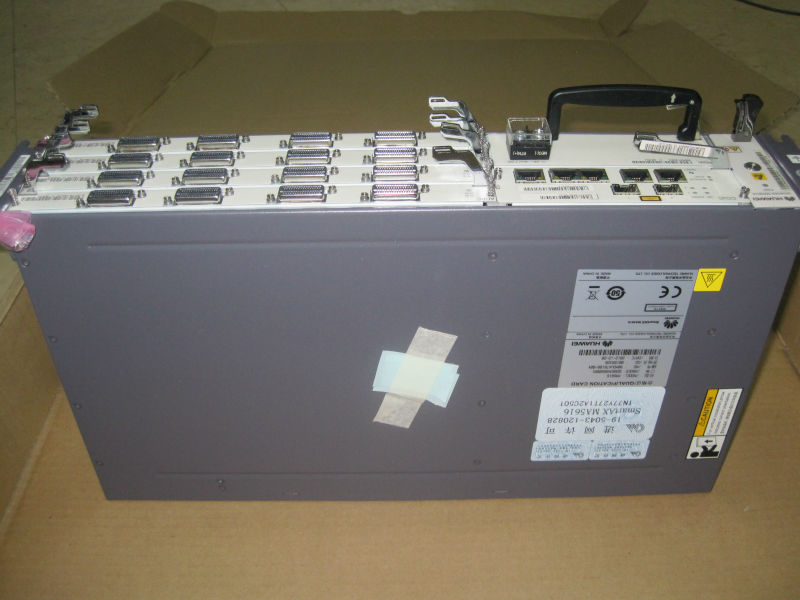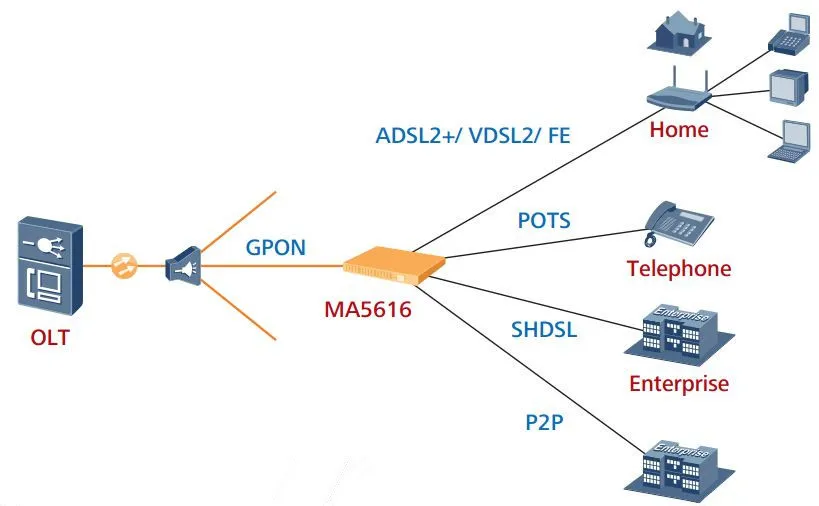Structure

The service boards supported by the MA5616 are as follows:
- When the control board is CCUB, the MA5616 supports xDSL, ISDN, and POTS, and ADSL2+ and POTS COMBO service boards.
The configuration principles for the service boards are as follows:
- Providing the POTS service boards that can be configured in all the four slots.
- Providing the ISDN service boards that can be configured in all the four slots.
- Providing the ADSL2+ service boards that can be configured in all the four slots.
- Providing the ADSL2+ and POTS COMBO service boards that can be configured in all the four slots.
- Providing the VDSL2 service boards that can be configured in all the four slots.
- Providing the SHDSL service boards that can be configured in all the four slots.
Product Feature
1.Unique Design of the COMBO
With the unique design of the COMBO board (CALE board), the MA5616 integrates 32-port ADSL2+ access, 32-port POTS access, and 32-port embedded splitter, providing high-density access services for users.
The CALE board, the COMBO board with the highest density for scale commercial application in the industry, has the following advantages:
- Saves the construction cost for carriers: saving the space of the equipment room and MDF and saving the wire bonding time
- Saves the maintenance cost for carriers: easy maintenance and energy saving
2 Rich and Complete Specifications
The MA5616 provides multiple specifications. Carriers can choose the ideal one according to the user density, thus best balancing the input and output.
The MA5616 supports dual GE, and single GE + single GPON upstream transmission flexibly according to application scenarios and network construction modes. Port 1 on the MA5616 can be a GPON or GE optical port, and port 0 can only be a GE optical port. Users can configure upstream data on port 0 or a GE electrical port on the panel.
|
Service Type
|
Number of Ports (Supported Board)
|
|
ADSL2+
|
32
|
|
VDSL2
|
16 (VDGE)/24 (VDSH/VDTH/VDSE)
|
|
SHDSL
|
16
|
|
POTS
|
32 (ASRB)/64 (ASPB)
|
|
ISDN
|
8
|
|
POTS + ADSL2+
|
32 POTS + 32 ADSL2+
|
3.Highly Effective Manageability and Maintainability
The MA5616 supports multiple highly effective management and maintenance methods, such as free of field software commissioning, remote acceptance, remote upgrade and patch installation, and remote fault location.
One-Site Deployment and Plug and Play
In PON upstream transmission Mode, the MA5616 supports:
-
Offline deployment and plug and play (PnP) are supported. The hardware installation engineer can perform one-site deployment for the MA5616.
-
The MA5616 can automatically obtain the configuration data from the NMS and report information about MxU online to the NMS. The configuration data automatically takes effect.
Remote Batch Upgrading
- The MA5616 supports automatic batch upgrading. After the upgrading policies are defined on the NMS, the NMS automatically upgrades network elements (NEs) in batches at a specified time.
- The ONU can be upgraded using the OLT.
- The MA5616 supports batch upgrading. When MA5616s are upgraded using the OLT, the upgrade efficiency is 6000MA5616s per five hours. When MA5616s are upgraded through the NMS, the upgrade efficiency is 800 MA5616s per five hours.
- If the upgrading fails, automatic rollback is supported to restore the original version and data, thus ensuring the system security.
Zero Touch Routine Maintenance
- Accurate fault location
- POTS call emulation, PPPoE dialup emulation, and multicast service emulation
- Circuit line test and loop line test on the POTS port, DELT, SELT, and MELT on the VDSL port
- Channel loopback detection, chipset loopback detection, and ring network detection
- Ethernet connectivity fault management (CFM) operation, administration and maintenance (OAM) (IEEE Std 802.1ag), implementing the Ethernet monitoring and fault diagnosing
- Remote troubleshooting
- Remote maintenance, thus reducing the operational expenditure (OPEX)
- Remote patch installation in batches
- Over-temperature protection (automatic recovery)
- Self-healing function (automatic reset upon the exhaustion of ONU dynamic resources)
- Remote reset of the system and remote reset of the service board upon power-off
- Comprehensive information collection
- Packet statistics (multicast packets and PPPoE packets)
- Backing up and uploading configuration data
- Obtaining the accurate record of operation logs
- Temperature detection
- Fan monitoring unit, H831PMU, H831VESC, ESCM(MiniESC), EPS30-4815AF(Power4830), implementing environment monitoring and management
- Boolean value monitoring (The Boolean values such as temperature, door status, and lightning can be monitored.)
- Self-check and diagnosis of the device
- LOS alarm and dying gasp alarm, identifying the disconnection of the ONU caused by broken optical fiber or power-off (Dying gasp: The system detects the output of the ONU power module. If the voltage drop is lower than the threshold, the system generates an alarm.)
- Working with the N2510 (line assurance system launched by Huawei) to support intelligent diagnosis (The N2510 performs the intelligent diagnosis and sends the diagnosis result to the ONU, implementing automatic line optimization for the ONU.)
Network Performance Monitoring
- Network optimization: The system monitors the traffic on the network side periodically. If traffic bottleneck occurs, the system adjusts the network resources and optimizes the network structure.
- User monitoring: The system performs selective monitoring on the traffic of the user port to find abnormal traffic and invalid users.
4.High QoS
The MA5616 provides high quality of service (QoS) solutions to facilitate the management of different services.
The QoS features of the MA5616 are as follows:
- Dynamic bandwidth allocation (DBA)-based bandwidth management supported by GPON ports
- Upstream GPON port supports eight T-CONTs and each upstream T-CONT supports four queues
- T-CONT-based priority service in the upstream GPON transmission direction. Each service port has eight class of service (CoS) queues numbered from 0 to 7. Queue 7 has the highest priority and queue 0 has the lowest priority
- Priority marking of the traffic-stream-based inner and outer VLAN tags
- Access control list (ACL)-based priority marking
- Three scheduling modes, namely, priority queuing (PQ), weighted round robin (WRR), and PQ + WRR
- Mapping upstream/downstream services to different priority queues for scheduling based on the priority
- ACL-based port rate limitation and traffic statistics
- Two rate three color marker (trTCM)-based IP traffic profile and rate limitation on user port
- Traffic shaping of port-level queue groups
5.Carrier-Class Reliability Design
The system reliability is taken into consideration in the system, hardware, and software designs of the MA5616 to ensure that the device runs in the normal state.
Hardware Design
The MA5616 supports the following functions:
- Complying with carrier-class reliability specifications.
- Featuring comprehensive exception handling capability.
- Passing the electrostatic discharge (ESD) test.
- Providing lightning protection and anti-interference functions.
- Starting up at a low temperature of -25°C.
- Enduring high temperatures and it can work normally for a long time at 65°C (the temperature is the temperature of the air intake vent of the cabinet).
- Detecting the temperature. When the temperature exceeds the threshold, the system generates an alarm.
- Protecting the subscriber port:
- DSL port: 4 kV in transverse and port-to-earth directions, comply with K21
- POTS port: 4 kV in transverse and port-to-earth directions, comply with K21
- ISDN port: 4 kV in transverse and port-to-earth directions, comply with K21
- GE port: 6 kV in common mode
- Protecting the power:In the AC + backup power configuration, the battery can be used as the backup power. When the AC power supply fails, the battery supplies power to the system. After the broadband service interruption feature is enabled, the broadband services are interrupted, and the narrowband services are normal.
- DC: 3 kV in differential mode and 5 kV in common mode
- AC: 6 kV
- Controlling the fan. The speed of the fan can be adjusted intelligently. That is, the system can automatically adjust the fan rotating speed according to the working temperature, which has positive effect on reliable energy saving and noise reduction.
- Replacing the fan tray independently.
- Adopts the derating design for the electronic components to improve the reliability.
- Provides the corrosion-proof design and reduces the cable routing on the board surface. A proper thermal design produces a temperature difference to prevent condensation.
- Supporting H.248 dual homing. When the H.248 protocol is used, the MDU can be configured with up to two MGCs. When the MGC is switched over or the MDU detects the fault of the primary upstream link, the system automatically switches to the other MGC.
- Supporting SIP dual homing. The MDU supports the 1+1 mutual assistance mode of the upstream P-CSCF/PROXY, that is, the deployment in the active/standby mode. When one of the upstream active/standby devices is faulty, the MDU service automatically switches to another device. Thus, the SIP disaster recovery scheme is implemented to improve the access reliability of the device.
- Supporting the emergency standalone. When the MDU upstream port fails, the system automatically starts the emergency standalone function. Then, the subscribers of the same MDU can call and communicate with each other.
- Supporting virtual noise. The system uses the virtual noise mechanism to decrease the line rate (the system adjusts the line rate according to the SNR), which improves the anti-interference capability of the system.
Software Design
The MA5616 supports the following functions:
- Complying with the modularized and platform-based design concept, and adopts the loosely coupled design for each software module.
- Adopting advanced design principles, such as object-orientation, error tolerance, error correction, and automatic recovery.
- Complying with the capability maturity model (CMM).
6.Strict Security
After deeply studying and applying security-related protocols, Huawei launches the MA5616 that meets the security requirements for telecom services and ensures the security of the system and the subscriber.
7.Perfect Voice Features
The MA5616 has built-in access gateway (AG) and inherits the platform capability and intercommunication capability of Huawei large-capacity AGs.
- H.248/SIP
- Up to 256 voice subscribers
- Basic services and enhanced services of VoIP/FoIP/MoIP
- Transmission of special signals (the fax event, modem event, pulse number, and hookflash event) through RFC2833
- H.248/SIP dual-homing
- Centrix function
- H.248 performance statistics and call statistics
- G.711A/Mu encoding and decoding with packetization duration of 10 ms, 20 ms, or 30 ms
- G.729 encoding and decoding with packetization duration of 10 ms, 20 ms or 30 ms
- RFC2833 (only H.248), RFC2198, echo cancellation (EC), voice activity detection (VAD), dual tone multi-frequency (DTMF), and modem quality enhancement
- Circuit and loop line tests, call emulation test, and connectivity test
- Remote fault location through remote packet capture and E2E signaling analysis
- Configuring the local digitmap
- Digitmap with the length of 8 K bytes
- Canceling the prefix of a telephone number over SIP
- Obtaining local IP addresses through the DHCP client to function as the signaling IP address and media IP address of the voice gateway
- Configuring and canceling the IP SPC service
- Once reboot of the device for pre-installation in H.248-to-SIP scenario
- Detecting the search tone and dial tone


